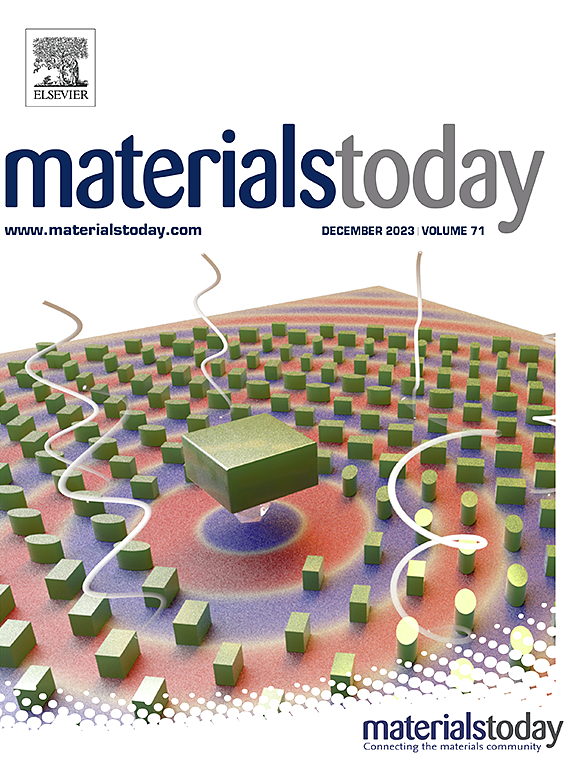Pioneering hydrogel cooling technologies: A comprehensive approach to theoretical modeling and one-step fabrication strategy
IF 21.1
1区 材料科学
Q1 MATERIALS SCIENCE, MULTIDISCIPLINARY
引用次数: 0
Abstract
To address the pressing challenges of economic loss and environmental concerns in the cold-chain sector due to temperature-related degradation and microbial contamination, we introduce reusable hydrogel cooling technology. “Jelly Ice Cubes” (JICs), bio-based hydrogel coolants offering a sustainable and efficient alternative to traditional cooling agents. This study reveals for the first time that the essence of designing any hydrogel coolant hinges on establishing an ideal structure, which maintains freezable water within a heterogeneously distributed closed-cell matrix crucial for stable superior cooling performance. A mathematical model was developed to define the optimal parameters for the structure of a closed-cell matrix, maximizing its water-retaining and heat-absorbing capabilities. Specifically, we explicitly explained how the size of enclosed chambers varies with the changes in biopolymer molecular size and concentration, as well as freezable water content in the hydrogel. Moreover, scalable one-step chemical crosslinking processes were developed based on the optimized structure provided by the models, enabling controllable gelatin crosslinking in hydrogels to achieve the desired structural features. The JICs demonstrate significant promise for decarbonization efforts in many fields, especially by optimizing packaging efficiency in cold-chain logistics. This research not only bridges a significant gap by applying a theory-driven approach to the development of sustainable hydrogel-based cooling technologies, but also sets a new standard for future innovations in the field.

开创性的水凝胶冷却技术:理论建模和一步制造策略的综合方法
为了解决冷链行业由于温度相关降解和微生物污染而造成的经济损失和环境问题的紧迫挑战,我们引入了可重复使用的水凝胶冷却技术。“果冻冰块”(JICs)是一种生物基水凝胶冷却剂,是传统冷却剂的一种可持续、高效的替代品。这项研究首次揭示了设计任何水凝胶冷却剂的本质取决于建立一种理想的结构,这种结构可以将可冻结的水保持在非均匀分布的闭孔矩阵中,这对于稳定的优越冷却性能至关重要。开发了一个数学模型来定义闭孔矩阵结构的最佳参数,以最大限度地提高其保水和吸热能力。具体来说,我们明确地解释了封闭腔室的大小如何随着生物聚合物分子大小和浓度的变化以及水凝胶中可冷冻水的含量的变化而变化。此外,基于模型提供的优化结构,开发了可扩展的一步化学交联工艺,使明胶在水凝胶中可控交联,实现了所需的结构特征。JICs在许多领域展示了脱碳努力的重大承诺,特别是通过优化冷链物流中的包装效率。这项研究不仅通过应用理论驱动的方法来开发可持续的水凝胶冷却技术,弥合了巨大的差距,而且为该领域未来的创新设定了新的标准。
本文章由计算机程序翻译,如有差异,请以英文原文为准。
求助全文
约1分钟内获得全文
求助全文
来源期刊

Materials Today
工程技术-材料科学:综合
CiteScore
36.30
自引率
1.20%
发文量
237
审稿时长
23 days
期刊介绍:
Materials Today is the leading journal in the Materials Today family, focusing on the latest and most impactful work in the materials science community. With a reputation for excellence in news and reviews, the journal has now expanded its coverage to include original research and aims to be at the forefront of the field.
We welcome comprehensive articles, short communications, and review articles from established leaders in the rapidly evolving fields of materials science and related disciplines. We strive to provide authors with rigorous peer review, fast publication, and maximum exposure for their work. While we only accept the most significant manuscripts, our speedy evaluation process ensures that there are no unnecessary publication delays.
 求助内容:
求助内容: 应助结果提醒方式:
应助结果提醒方式:


